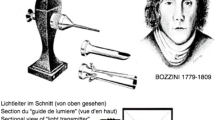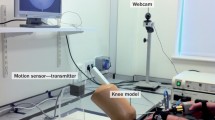Abstract
With advancement in arthroscopic and endoscopic technique and instruments, arthroscopy has become feasible in most human joints and extra-articular potential spaces. With the introduction of this minimal invasive technique, a wide variety of treatment can be performed without the need of traditional open surgery. Arthroscopic and endoscopic approaches have the advantages of better visualization by magnified arthroscopic views, minimal trauma to the surrounding soft tissues, and less post-operative pain. In this chapter, the operative room setup, patient positioning, and instruments for hip and knee endoscopy are described.
Access provided by Autonomous University of Puebla. Download chapter PDF
Similar content being viewed by others
Keywords
1 Patient Position
Most endoscopic knee and hip procedures can be performed in supine and lateral positions. Floppy lateral position can be employed for knee endoscopy for flexibility when both anterior and lateral access are important. The knee can be flexed by using leg holder and dropping the foot of the bed, or by using foot rest or posterior wedge with a full table (Fig. 3.1). Mechanical positioners, some motorized, are available for versatile and dynamic positioning for specific procedures. Precautions should be employed for the pressure-sensitive areas during lateral positioning. Pelvic holders can ensure the stability of lateral positioning. Whilst traction is necessary in certain endoscopic procedures of the hip (Fig. 3.2), care should be taken to avoid distraction injury and compression injury to the perineum by countertraction [1]. Post-less distraction options are being developed.
2 Theatre Arrangement
Factors to be taken into consideration for theatre arrangement include anaesthetic arrangement, surgical instruments and equipment, fluoroscopy requirement, overall theatre flow, and surgeon ergonomics. The theatre setup should be tailored to the specific procedure. In general, for endoscopic procedures, the chief surgeon and the assistants should be positioned on the ipsilateral side of the operative site whilst the endoscopy tower and fluid management devices should be positioned on the contralateral side. The scrub nurse and the back sterile instrument table are usually placed behind the surgical team. Mayo trays are used to place the frequently used instruments, such as the camera and scope assembly, trocar and cannula, motorized shaver, radiofrequency probe, and switching sticks, close to the operative site for efficient access.
2.1 Instruments
2.1.1 Scopes
Standard arthroscopes with 30°or 70° inclination (Fig. 3.3) can be used for hip and knee endoscopic procedures. 4 mm arthroscopes have optical field of view of 115°. By rotating a 30° scope along its axis, a scanning field of view of 175° can be achieved. While most procedures can be performed using 30° scopes, 70° scopes can provide better view round corners. This is especially useful when the manoeuvring of the scope is limited by the bony anatomy, tight fascial layers, and deep tissue tract. Orientation with a 70° scope can be difficult especially for beginners. Whilst 70° 4 mm scopes can achieve a scanning field of view of 255°, surgeons must be aware of the 25° of blind field in the middle to avoid missed pathologies.
2.1.2 Fluid Management System
Fluid management system is important for the optimization of visualization and distension of working space. When application of tourniquet is not desirable or possible, achieving tamponade effect on bleeding with adequate fluid pressure is important. Consistent flow can constantly refresh the visualization medium. Automated peristaltic fluid pump systems with pressure and flow regulation (Fig. 3.4) can generate consistent flows with greater degree of joint distension. Real-time regulation of fluid flow can compensate for the rapid volume loss during the use of motorized instruments with suction. Whilst inadequate pressure and flow can limit visualization, high pressure can lead to inadvertent fluid extravasation. Apart from local complications, intra-abdominal fluid extravasation during hip arthroscopy or endoscopy can cause intra-abdominal compartment syndrome which is potentially life-threatening. The prevalence of symptomatic intra-abdominal fluid extravasation has been reported to be 0.16% in a multicentre study [2]. Intra-thoracic fluid extravasation after hip arthroscopy has also been reported [3]. Low-cost gravity flow systems were first described and are still commonly used. Although the flow rate is controlled by the flow resistance of the system, which is relatively fixed, desired pressure can be reliably achieved by elevating the fluid bag above the infusion site by specific distances. 1 m of elevation corresponds to approximately 70 mmHg of pressure. In a cadaveric study, gravity feed was proven to be accurate with minimal pressure overshoot and lower intra-articular pressure ranges [4]. With the understanding of the different properties, the choice of irrigation system should be made based on the individual scenario.
2.1.3 Cannulas
Whilst most rigid scopes have accompanying cannulas, working portal access cannulas are optional depending on the portal location, depth, and application. They are often utilized for locations where maintenance of soft tissue tract is difficult. They can also assist suture management. Spigots are usually available for fluid delivery or drainage. Metallic reusable and plastic disposable cannulas are available on the market. Hard cannulas are pierce resistant but its rigidity may limit manoeuvrability. Soft cannulas are more flexible but they are not suitable for sharp-tipped instruments. Most disposable cannulas are held in place during procedure by threads or lips. Some soft cannulas have wide internal flanges to increase fall-out resistance and to assist internal soft tissue retraction. Open, or half-pipe, cannulas are commonly used for hip arthroscopic instruments exchange.
2.1.4 Hand Instruments
The probe is an important diagnostic instrument. It provides tactile feedback so that the consistency and continuity of deep structures can be better evaluated in addition to the visual information provided by the scope. Most probes have 90° bend at their ends which form hooks of 3–4 mm long with rounded blunt tips. The knowledge of the hook size can be used to estimate the size of lesions. The probe is also useful for suture manipulation and soft tissue handling. Cutting instruments comes in the form of cutting blades, straight scissors, hooked scissors, retrograde hooked knife, and punches of various attack angles (Fig. 3.5). Whilst straight cutting blades and scissors can precisely separate structures in tension, loose soft tissue often “escape” the cutting jaws. Hooked scissors and punches are more suitable for separation of loose tissue. With the development of motorized instruments and radiofrequency devices, the roles of many traditional cutting instruments are gradually being replaced. Antegrade and retrograde suture passing devices with various attack angles are available (Fig. 3.6). Caution should be taken when choosing instrument for suture handling. Whilst graspers are suitable for loose bodies retrieval, their sharp grasping teeth can inadvertently abrade suture fibres and jeopardize the security of tissue repair. Suture retrievers and probes should be used for the purpose.
2.1.5 Motorized Instruments
Motorized instruments deliver their action by either rotatory or reciprocating motion. The most commonly used motorized instrument is the shaver. Used in conjunction with controlled suction, the shaver can efficiently clear the path for visualization and excise pathological structures. The oscillating mode can prevent tissue tangling caused by unidirectional rotation. Burr with protection sleeve is suitable for endoscopic osseous excision and preparation. Reciprocating file can generate flat bony surfaces which are difficult to achieve with burr. With reciprocating saw, endoscopic osteotomy can be performed with minimal bone loss.
2.1.6 Radiofrequency Devices
Radiofrequency probes are electrical devices which employ high frequency alternating electrical current for heat generation to achieve tissue coagulation or ablation. With conventional monopolar radiofrequency devices, the current oscillates between the active electrode and the patient return electrode. Heat is electrically induced close to the tip of the active electrode, where the current density is the highest. Instead of passing electrical current through tissue, modern radiofrequency instruments, such as Coblation-based devices (Fig. 3.7) use bipolar electrodes to generate a focused plasma layer which coagulate or ablate soft tissue at lower temperatures (25–35 °C) with lower thermal penetration and thus more targeted energy delivery [5]. Some systems have built-in suction pump with variable suction pressure for different energy delivery modes. Bipolar radiofrequency devices have been proven to be time and cost saving compared with monopolar devices.
References
Papavasiliou AV, Bardakos NV. Complications of arthroscopic surgery of the hip. Bone Joint Res. 2012;1(7):131–44.
Kocher MS, Frank JS, Nasreddine AY, Safran MR, Philippon MJ, Sekiya JK, et al. Intra-abdominal fluid extravasation during hip arthroscopy: a survey of the MAHORN group. Arthroscopy. 2012;28(11):1654–60.e2.
Verma M, Sekiya JK. Intrathoracic fluid extravasation after hip arthroscopy. Arthroscopy. 2010;26(9 Suppl):S90–4.
Mayo M, Wolsky R, Baldini T, Vezeridis PS, Bravman JT. Gravity fluid flow more accurately reflects joint fluid pressure compared with commercial peristaltic pump systems in a cadaveric model. Arthroscopy. 2018;34(12):3132–8.
Anderson SR, Faucett SC, Flanigan DC, Gmabardella RA, Amin NH. The history of radiofrequency energy and Coblation in arthroscopy: a current concepts review of its application in chondroplasty of the knee. J Exp Orthop. 2019;6(1):1.
Author information
Authors and Affiliations
Editor information
Editors and Affiliations
Rights and permissions
Copyright information
© 2021 The Author(s), under exclusive license to Springer Nature Singapore Pte Ltd.
About this chapter
Cite this chapter
Mak, C.Y., Lui, T.H. (2021). Setup and Instruments. In: Lui, T.H. (eds) Endoscopy of the Hip and Knee. Springer, Singapore. https://doi.org/10.1007/978-981-16-3488-8_3
Download citation
DOI: https://doi.org/10.1007/978-981-16-3488-8_3
Published:
Publisher Name: Springer, Singapore
Print ISBN: 978-981-16-3487-1
Online ISBN: 978-981-16-3488-8
eBook Packages: MedicineMedicine (R0)











